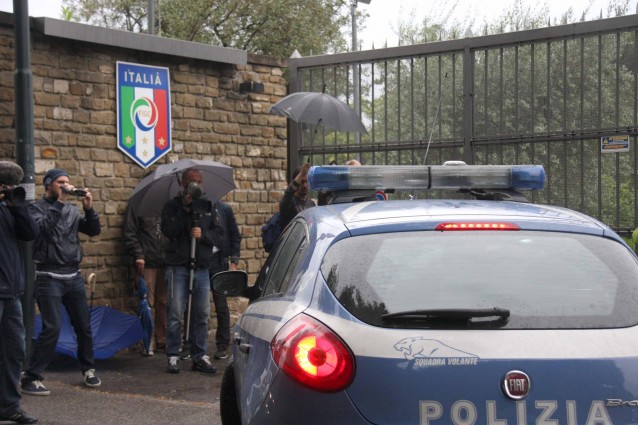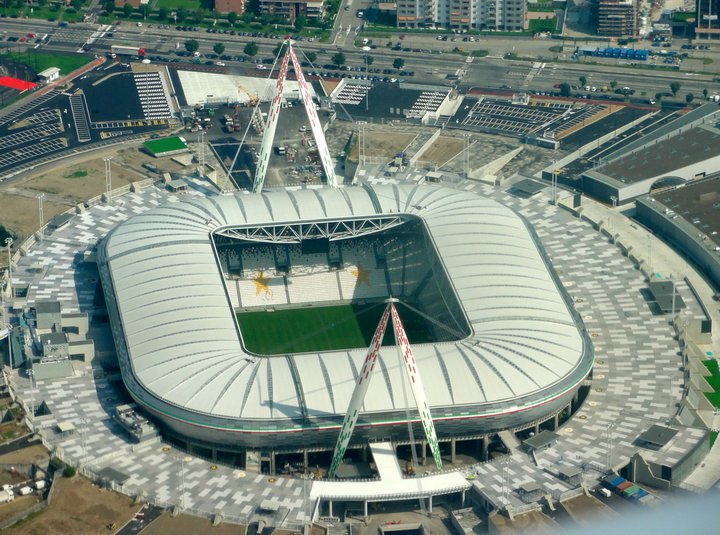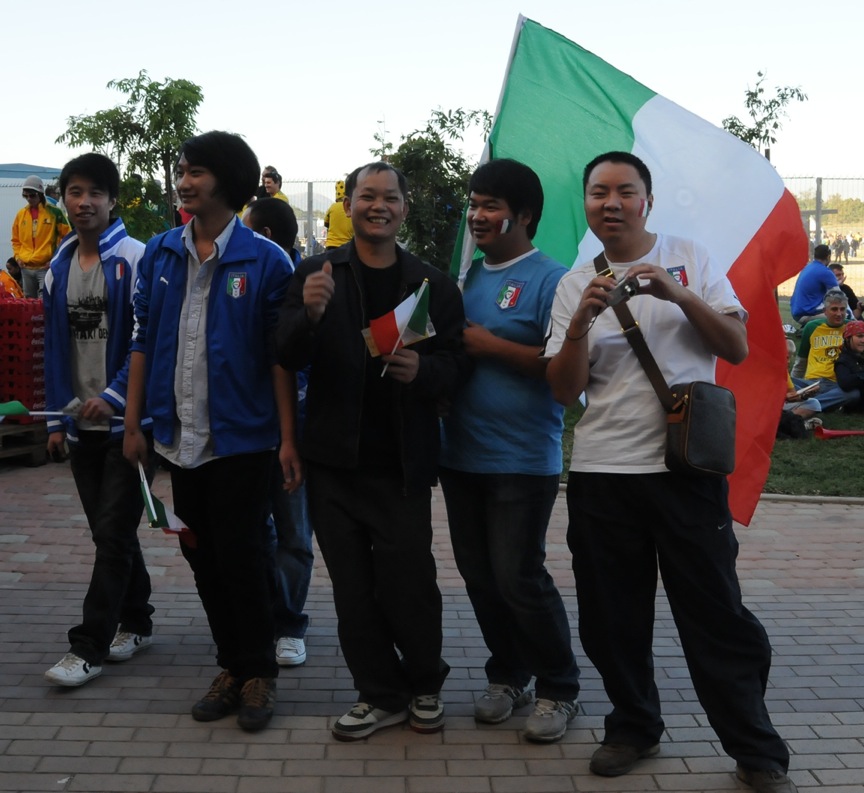July 11, 1982: the World Cup final at the Santiago Bernabeu in Madrid. Four years earlier, West Germany had drawn 0-0 against a young, enterprising Italian side in the second group stage of the 1978 World Cup — the Argentinean Generals’ Mundial. (Video highlights here.)
1978 was also the year of the assassination of Italian Prime Minister Aldo Moro (who was held for a month in an apartment building adjacent to my elementary school), and the inauguration of President Sandro Pertini, a dedicated socialist and former anti-Fascist resistance fighter. We didn’t know it back then, but “The Years of Lead” were about to come to an end. Football — or calcio as we call it — was about to show us that the road to the future went beyond Left and Right.
With the pipe-smoking Pertini enjoying the 1982 final next to King Juan Carlos in the VIP section of Real Madrid’s majestic stadium, the Azzurri demolished the (West) Germans 3-1. Not everything went perfectly that night. Graziani’s injury forced an early substitution and then Cabrini — my mother’s favorite player — missed a penalty: the only time I ever heard my uncle, a man of the cloth, swear audibly.
The second half was all Italy. Physically and mentally fatigued after their penalty shootout victory gainst Michel Platini’s France in an extraordinary semifinal (highlights here), Germany caved in. Paolo Rossi opened the score with his sixth goal of the tournament and then Tardelli made it 2-0, celebrating it with such emotional abandon that we imitated it for years on playgrounds and pitches around the land.
When Altobelli added a third late in the game Pertini leaped out of his seat, waving his arms, rejoicing, telling everyone around him that “adesso non ci prendono più!” (Now they’re not going to catch us anymore!). Breitner got a consolation goal, but it didn’t matter. When the Brazilian referee theatrically picked up the ball with his hands, raised it above his head and blew the final whistle, match announcer Nando Martellini pronounced to the masses that we were “Campioni del Mondo! Campioni del Mondo! Campioni del Mondo!”
Millions of Italians thundered in a massive impromptu street carnival the likes of which had not been seen, the elders told us, since Liberation. Giving in to pleas from me and my friend Fabio, my uncle, in his clerical collar, honked his rickety FIAT 127’s horn all the way from our parish in the Marche hills to coastal Pesaro so that we could experience these historic celebrations. A quarter of a century later, another generation would experience the intoxicating feeling of World Cup victory . . . and Germany, once again, would play a key role in Italy’s success story.
Come back tomorrow for the final installment of Germany’s history of failure against Italy.
Tag: Italy
Germany’s History of Failure Against Italy
Germany is favored to win Thursday’s Euro 2012 semifinal against Italy. While Die Manschschaft has played the best and most consistent football in the tournament, the Azzurri have won just one game in regulation and reached the semifinal only after surviving a penalty shootout against England. History provides a counterpoint to soccernomics-style prognostications, however, because the Germans — or West Germans — have never defeated Italy in Euros or World Cup tournaments.
It started with a forgettable goalless draw at the 1962 World Cup in Santiago del Chile, but ignited in a globally televised World Cup semifinal played at the Azteca Stadium in Mexico City on June 17, 1970, which Italy won 4-3 in extra time. Outside the Azteca a plaque commemorates it as “The Match of the Century.” The video above combines footage of the original broadcast with Fabio Caressa’s 21st-century play-by-play commentary. Rumor has it that this clip is streaming on a loop in the Azzurri’s team hotel . . .
Come back tomorrow for part 2 of Germany’s history of football failure against Italy.
The Italian Job: Revisited

Police raid the Italian national team camp and an earthquake in Emilia-Romagna forces the cancellation of the Italy-Luxembourg Euro warm-up. It’s been a tough week for Italian tifosi, on and off the pitch.
Defender Domenico Criscito left the Euro squad after being implicated in the latest wave of prosecutorial investigations and charges. Meanwhile, Antonio Di Natale emerged as a pale as a ghost after riding out the 5.9 magnitude quake in an elevator.
The latest developments in calcio’s corruption and match fixing scandal have produced 19 arrests, including that of Lazio captain Stefano Mauri and ex-Genoa man Omar Milanetto. Prosecutors in Bari, Cremona, and Napoli have also implicated several dozen high profile players, managers, and club officials. That this mess is taking place only a few years after “calciopoli” — which famously landed Juve in serie B and penalized Milan, Lazio, and Fiorentina — is a potent indictment of the Italian football system and its willingness or ability to reform itself.
Italian authorities and prosecutors inspire confidence in some circles that the metastasizing problem will finally be addressed (read Declan Hill’s blog post here), but I find this optimistic view problematic on a number of levels. Here’s why:
First, the justice system in Italy is utterly dysfunctional. From civil to criminal cases, almost nothing works properly. The country has more than 10,000 laws on the books, that’s more than most, if not all, other countries in the world. Moreover, culprits of egregious crimes are often let off the hook with little more than a slap on the wrist while minor cases take years to resolve. And that’s just the tip of the iceberg.
Second, calcio works exactly like Italian politics. Family and “big man” cliques dominate and actively seek to expand their narrow interests against the common good. From serie A and B all the way to the lowest amateur ranks, this situation makes it almost impossible to develop a fair, equitable, and sustainable solution to the football rot.
Third, Italian sport and society struggle with a culture of cheating that pivots around what may be labeled “situational ethics” and a common sense rationalization that laws are made to be circumvented.
Given this dispiriting local situation and a worrisome rise in match fixing, corruption, and bribery on a global level, the Italian Prime Minister Mario Monti’s recent statement “that it would really benefit the maturity of us Italian citizens if this game was completely suspended” for a couple of years seems like a good idea. It might create the space needed for a soul-searching dialogue aimed at finding long-term solutions to calcio’s spiral of decline.
Juventus Stadium: Changing Calcio

Although I was born and raised in Rome, I support Juve. My choice was based on the need to find a club that could compete with AC Milan and Inter, my older brothers’ favorite teams. I was barely six years old when I first saw Juve play. It was in Perugia (my father’s team) and “we” somehow lost 0-1 thanks to a goal by Renato Curi. As a result, Torino won the scudetto. What a tragedy! But the real tragedy happened a year later when I returned to Perugia hoping for a better Juve performance: Curi collapsed on the pitch and died of a heart attack. Talk about putting things in perspective.
Over the next decade, I watched Juve “under cover” at the Olimpico against Roma and Lazio, and in other cities as well. It could be dangerous. At Marassi stadium, for instance, Genoa’s ultras invaded our curva (end) wielding broken bottles. When all was said and done, a guy two rows in front of me was oozing blood from a stab wound in his leg. Surely it would have been safer in Turin, but as a young teenager living more than 400 miles away it was tough to make the pilgrimage to the Stadio Comunale. And after I moved to the United States in the mid-1980s, it seemed as if I had been sentenced to never attend a Juve “home” match. A victim of contrappasso for my act of betrayal of Roma and Lazio?
The inauguration of Juve’s new stadium is inspiring me to finally make the journey to Turin.
September 8, 2011, heralds the arrival of a new era in Italian football, or calcio as we call it. Juve’s friendly against Notts County — the club responsible for the Old Lady’s adoption of black-and-white kits — marks the first time an Italian club will play in its privately owned stadium.
It is a welcoming football-specific stadium: no track, no moat, no fence. It has a capacity of 41,000 seats and a design similar to many English Premier League grounds. Juve’s stadium provides a long-awaited alternative to overpriced, under-serviced, militarized, and outdated grounds found all over the peninsula. It rises on the ashes of its cursed predecessor, the Delle Alpi. Built on the outskirts of Turin for the 1990 World Cup, Delle Alpi stadium was twice as expensive as originally planned, featured terrible sight lines (largely due to a never-used running track), a bumpy playing surface, and abominably high maintenance costs. In 2003 Juve took it over from the city under a 99-year lease and demolition started in 2008. In the meantime, both Juve and Torino relocated to the downsized ex-Comunale stadium, renamed Olimpico after hosting the inaugural and closing ceremonies for the 2006 Winter Olympics.
Looking at the calendar, I could make the Piedmont derby between Juve and Novara on December 18 . . .
For a virtual tour of the new stadium click here. For videos documenting the construction process go here, here, here, here, here, here, and here.
On Sunday, October 17, 2010, history was made in the Italian serie A: a match was stopped due to fans’ racist chants. It happened at the Sant’Elia stadium in Cagliari (on the island of Sardinia). Just two minutes in, referee Paolo Tagliavento had enough of the monkey chants from the Cagliari ultras directed at Inter striker Samuel Eto’o.
Tagliavento blew his whistle, explained his decision to the two captains, then ordered the fourth official to have this announcement made over the stadium’s public address system: ‘If racist chants persist, the match will be suspended.’ It was repeated twice.
After the announcement no monkey chants poisoned the atmosphere. In a delicious twist to this sad affair, Eto’o went on to score the only goal of the match and celebrated by ‘monkeying’ around!
It’s taken three painful days to write something, anything resembling rational thought about Gli Azzurri. Last year I blogged about Italy’s impending demise under Lippi 2.0 — and eventually (inevitably?) Slovakia delivered the fatal blow at Ellis Park. Too many old, unmotivated players mixed with inexperienced, deer-in-the-headlights youngsters who folded at the first sign of pressure.
Since Thursday, my rage and disgust at Italy’s worst World Cup team of all time have subsided. The one sweet memory extracted from the Ellis Park debacle is captured in this video with Gigi Buffon graciously signing autographs for our kids before the Slovakia game. Grazie Gigi!
June 20, 2010
Nelspruit, Mpumalanga

Father’s Day with family on the road to Italy-New Zealand. It doesn’t get any better than this! There are six of us in the van, including Ignazio and Marco just in from Rome. We are all rigorously decked out in Italy jerseys. With Igna at the wheel, we leave Joburg around 9am. The Sunday journey is smooth and we go by sleepy towns — ‘burgs’ ‘dorps’ and ‘fonteins’ — in the winter Low Veld.
Our first and only pit stop is at a service station with many Azzurri fans. Listening to them speak, I realize that very few are actually Italians. Most are South Africans of various backgrounds buying into the Italy brand — we dub them ‘Fake Italians’.
Back on the road we wind out way through the canyons of Mpumalanga. The scenic road is treacherous and we make a note of that for the postmatch return trip. 3.5 hours later we are outside Nelspruit, but miss the stadium exit due to poor signage. A burly yet friendly traffic cop on the freeway points the way back to it: ‘Make a safe u-turn,’ he tells us with a smile, ‘we don’t want you to die in South Africa.’
Ten minutes (and no signs) later we are at the Riverside Mall park-and-ride, but it’s full so we go to the Showgrounds instead. That country fair feeling again, shades of Polokwane. Our crew boards the bus, there are more ‘Fake Italians’! At 2:45 we arrive outside the Mbombela Stadium perched at the top of a hill with nothing around it. The landscaping is not finished so the ground has a construction site feel to it. It’s built on a land claim, entailed forced removals of two schools, and the corruption connected to the building of the stadium led to the murder of two whistleblowers.
But we are thinking of the match not blood and bribery. Will the Azzurri deliver against NZ? The answer becomes clear immediately after kick off. On the Kiwis first sniff of our goal they score. Oh my. Drunken New Zealanders just got more annoying, as they would spend the rest of the match hurling insults at the Azzurri. I reciprocate in kind when Iaquinta levels the score on a penalty midway through the first half. Italy seems bent on imitating lackluster France in this World Cup. It ends 1-1, which the All-White fans celebrate as if they had won the World Cup.
I gloomily exit the arena with kids in hand thinking of what might have been with Balotelli, Cassano . . . The Fake Italians don’t seem affected by this embarrassing draw. Brand loyalty is about consumption and vicarious association, not nausea and disgust at having driven 370km to endure unforgivably pathetic football against a team ranked 107 in the FIFA rankings.
We shuffle our way through the crowd at the shuttle buses and jump on board. Within a few minutes we are at the Showgrounds park-and-ride and our diesel engine is rumbling. It’s dark when we leave Nelspruit for Joburg. We drive cautiously, thinking about Netherlands-Italy in the round of 16 (we have Durban tickets) and the ‘High Accident Zones’ signs on the road. An Opel Corsa and several other cars with Gauteng license plates pass us. An all-encompassing foul odor fills the odor — it’s coming from a huge saw mill — ‘Who farted’? the children joke.
Then, two minutes later, a horrific scene. The Corsa that just passed us is a smoking carcass on the side of the road. A bakkie is overturned on the other side. A third car is crumpled. We order the kids not to look, but they do and are terribly shaken by the accident that happened maybe 2 minutes before. We drive even more carefully the rest of the way. On Monday, Radio 702 announces that four young South Africans died in the crash near Belfast, Mpumalanga. They were Italy supporters. Our condolences to their families. Today, there are no Fake Italians.